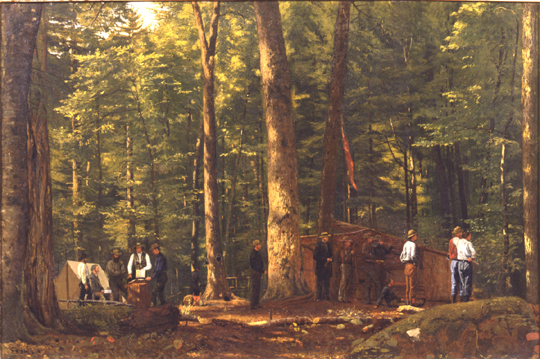 |
STILLMAN’S PHILOSOPHERS’
CAMP
80. William James Stillman. The Philosophers’
Camp in the Adirondacks, 1858. Oil on canvas. From the
bequest of Ebenezer Rockwood Hoar, 1895.
This painting—one of the best-known in the Concord Free Public Library art collection—includes the figures of both Ralph Waldo Emerson (in the center, standing alone between two trees) and Ebenezer Rockwood Hoar (the first figure to the right of Emerson’s). It depicts a visit by the “Adirondack Club”—an offshoot of the Saturday Club—to the Adirondack wilderness in 1858. The trip was organized by William James Stillman (1828-1901), a friend of Saturday Club members and the painter of this piece. Stillman was a talented man of wide-ranging interests and occupations. He trained as an artist with Frederic Church—American landscape painter of the Hudson River school—and in London, where he was influenced by the pre-Raphaelites. He was also, at different points in his life, a journalist; a writer on art, current events, and other subjects; a diplomat (he was United States Consul in Crete and in Rome); a political activist, involved in Kossuth’s Hungarian revolution; and a photographer. He founded The Crayon, a journal of the graphic arts, and through this periodical became acquainted with a number of the writers and thinkers of his time. An outdoorsman, Stillman persuaded some of his friends in the Saturday Club to make a camping expedition to Follansbee Pond in the Adirondacks in 1858. The party included Emerson, James Russell Lowell, Louis Agassiz, Estes Howe, Jeffries Wyman, John Holmes, E.R. Hoar, Horatio Woodman, Amos Binney, Stillman, and a number of local Adirondack guides. Others were invited but declined to go. When Longfellow was asked, he inquired whether Emerson would be taking a gun. Told that Emerson would, in fact, have a gun, Longfellow replied that he wouldn’t go because someone was sure to be shot. Stillman’s Philosophers’ Camp is more than a record of the 1858 Adirondack Club trip. It represents the artist’s interpretation of the significance of that outing. Although Emerson’s figure does not dominate the painting, it is central. Behind Emerson (at the left), a cluster of campers is grouped around scientific naturalist Agassiz, who is dissecting a fish. In front of him (at the right), a group of marksmen engage in target practice under Stillman’s direction. (Stillman stands elbow-to-elbow with the figure raising a gun.) Emerson stands alone in the middle, soaking up the wild majesty around him, in contrast with his busy fellow campers, who are preoccupied with the concrete reality of nature. Stillman’s Emerson is moved by his immersion in the virgin forest and responds to it in a deeper, more spiritual way than the other campers. Emerson wrote a poem—“The Adirondacs”—about his experience on the 1858 trip. It was included in the collection May-Day (1867; Myerson A28). His son Edward later prepared a key identifying the vacationing “philosophers” in the painting (also in the Concord Free Public Library art collection).
No image in this online display may be reproduced in any form, including electronic, without permission from the Curator of Special Collections of the Concord Free Public Library.
Next Entry - Previous Entry - Back to Section VIII Contents Listing - Back to Exhibition Introduction - Back to Exhibition Table of Contents |